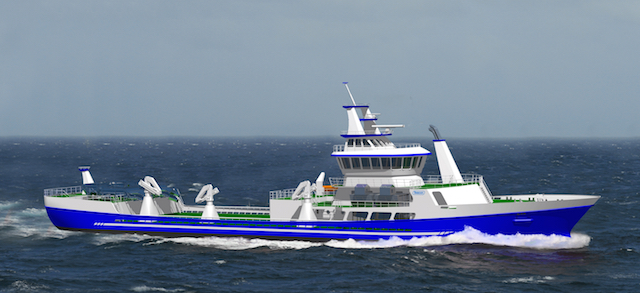
Marine Harvest invests $35 million in ‘fish spa’
October 28, 2016
By Tom Walker
 A rendering of the new vessel that will have a 3 Freshwater baths for fish use reverse osmosis water for sea lice treatment
A rendering of the new vessel that will have a 3 Freshwater baths for fish use reverse osmosis water for sea lice treatment
Marine Harvest Canada (MHC) is making a $35-million investment in a 75-metre vessel to support their integrated fish health management work.
“This is very proactive move for the company,” says Ian Roberts of MHC. “Our other management tools have been working for us, but our fish health staff and our veterinarians realize we need to ensure we are doing all that we can.”
The new vessel will have a 3,000-cubic meter freshwater capacity that can provide a freshwater bath for an entire pen (up to 50,000 fish). The company fondly refers to the boat as a “fish spa.”
Immersion in freshwater is a common practice in the salmon farming industry to improve gill health and to help remove external parasites.
“Freshwater baths are used in other aquaculture regions around the world to aid in fish health management,” says Dr Diane Morrison, director for Fish Health and Food Safety Director at MHC. “Our local trials have shown that the same method is extremely effective at removing sea lice and improving gill quality of our fish.”
Current practices of rigging a tarp over a pen, filling the tarp with water and transferring the fish into that water are cumbersome at best. The entire process relies on an available source of freshwater.
The new boat, which MH expects to receive late in 2017 will be a game-changer. “The advantages gained by using a custom-built freshwater well boat include having better control over the application, knowing your source of freshwater is high quality, and improving water quality during the treatment by being able to continually refresh and filter the system,” adds Morrison.
An on-board diesel powered reverse osmosis (RO) system will turn saltwater into freshwater. The boat will be located next to a net pen and the fish will be transferred from the pen to the boat where they will remain in the freshwater bath for three to five hours. The treated fish will be returned to the pen and the boat can move on to work with the next pen that afternoon. Accommodations for up to10 crew ensure they can access MHC’s more remote sites.
The water is continually being refreshed by the RO system and can be reused. Water is filtered before being discharged and all sea lice will be collected and composted.
Advertisement
“We expect that we will be able to treat all of our fish at their pen sites twice a year,” says Roberts. “In current trials, we are seeing an 85-percent reduction in parasites.”
While $35 million is a large investment, it supports the company’s commitment to reduce the use of medications in its operations. “The Aquaculture Stewardship Council, which we are adhering to, has metrics around medicinal use,” adds Roberts. “We plan on beating those metrics and this is one way to do that.”





